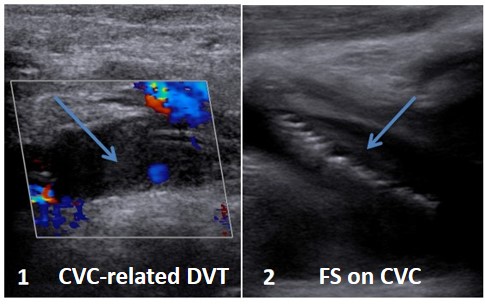FIBRIN SHEATHS ON CENTRAL VEIN CATHETERS AS A RISK FACTOR FOR DEEP VEIN THROMBOSIS IN CHILDREN WITH ACUTE LYMPHOBLASTIC LEUKEMIA
(Abstract release date: 05/19/16)
EHA Library. Fedorova D. 06/09/16; 133107; E1558

Ms. Daria Fedorova
Contributions
Contributions
Abstract
Abstract: E1558
Type: Eposter Presentation
Background
Indwelling of central vein catheter (CVC) is well known as a risk factor for deep vein thrombosis (DVT) especially in patients with malignancies. The term «CVC-related thrombosis» is attributed to mural thrombosis that involves CVC, adheres to vessel wall and partially or totally occludes the vessel lumen. However, presence of CVC in a central vein may result in emerging not only «true» mural thrombosis but so-called fibrin sheaths (FS) that envelope CVC but do not involve venous wall. Despite high FS incidence data on its clinical importance is scarce.
Aims
To investigate the role of FS in DVT development; to reveal the efficacy of anticoagulant therapy in patients with DVT with previous FS.
Methods
We analyzed data on 182 CVC inserted in 113 patients with acute lymphoblastic leukemia (ALL) aged from 1 to 19 years. Data were collected retrospectively from electronic hospital charts. The diagnosis of DVT and FS was made by means of echocardiography (ECHO) and Doppler ultrasound scanning (DUS) of extracranial brachiocephalic veins. DUS has been performed at different time after CVC implantation depending on clinical indications and physician’s opinion.A «p» value <0,05 was considered statistically significant. Data were analyzed using the IBM SPSS for Windows Software. Univariant logistic regression analysis was performed for estimation of FS significance for DVT development. Between group comparisons were performed by chi-square or Fisher’s exact test depending on sample value.
Results
FS were detected on 63 (35%) CVC. Incidence of FS was 2,71 events per 1000 catheter days. Catheter-related DVT was revealed in 51 (28%) cases. In 24 of them FS preceded DVT emerging. Presence of FS was significantly associated with subsequent DVT (odds ratio (OR) 2,75, 95% confidential interval (CI) 1,32-5,74, р=0,003). After detecting of FS, anticoagulant prophylaxis was started in 31 cases. In this group DVT subsequently developed in association with 15 (48%) CVC. In group that did not receive anticoagulants DVT developed in 9 (32%) cases. In both groups there was one occlusive DVT. Difference in DVT incidence between groups with and without anticoagulant prophylaxis after FS detecting was statistically insignificant (р=0,908). FS resolution occurred independently of anticoagulants usage (р=0,598).
Conclusion
According to our data, FS was detected on 35% of CVC. Presence of FS was associated with subsequent CVC-related DVT emerging. Efficiency of anticoagulants for FS resolving is doubtful. The question whether anticoagulant prophylaxis of DVT should be started after FS detecting remains unclear. Large prospective studies are required to resolve this issue.

Session topic: E-poster
Keyword(s): Anticoagulants, Catheter-related thrombosis, Children, Deep venous thrombosis
Type: Eposter Presentation
Background
Indwelling of central vein catheter (CVC) is well known as a risk factor for deep vein thrombosis (DVT) especially in patients with malignancies. The term «CVC-related thrombosis» is attributed to mural thrombosis that involves CVC, adheres to vessel wall and partially or totally occludes the vessel lumen. However, presence of CVC in a central vein may result in emerging not only «true» mural thrombosis but so-called fibrin sheaths (FS) that envelope CVC but do not involve venous wall. Despite high FS incidence data on its clinical importance is scarce.
Aims
To investigate the role of FS in DVT development; to reveal the efficacy of anticoagulant therapy in patients with DVT with previous FS.
Methods
We analyzed data on 182 CVC inserted in 113 patients with acute lymphoblastic leukemia (ALL) aged from 1 to 19 years. Data were collected retrospectively from electronic hospital charts. The diagnosis of DVT and FS was made by means of echocardiography (ECHO) and Doppler ultrasound scanning (DUS) of extracranial brachiocephalic veins. DUS has been performed at different time after CVC implantation depending on clinical indications and physician’s opinion.A «p» value <0,05 was considered statistically significant. Data were analyzed using the IBM SPSS for Windows Software. Univariant logistic regression analysis was performed for estimation of FS significance for DVT development. Between group comparisons were performed by chi-square or Fisher’s exact test depending on sample value.
Results
FS were detected on 63 (35%) CVC. Incidence of FS was 2,71 events per 1000 catheter days. Catheter-related DVT was revealed in 51 (28%) cases. In 24 of them FS preceded DVT emerging. Presence of FS was significantly associated with subsequent DVT (odds ratio (OR) 2,75, 95% confidential interval (CI) 1,32-5,74, р=0,003). After detecting of FS, anticoagulant prophylaxis was started in 31 cases. In this group DVT subsequently developed in association with 15 (48%) CVC. In group that did not receive anticoagulants DVT developed in 9 (32%) cases. In both groups there was one occlusive DVT. Difference in DVT incidence between groups with and without anticoagulant prophylaxis after FS detecting was statistically insignificant (р=0,908). FS resolution occurred independently of anticoagulants usage (р=0,598).
Conclusion
According to our data, FS was detected on 35% of CVC. Presence of FS was associated with subsequent CVC-related DVT emerging. Efficiency of anticoagulants for FS resolving is doubtful. The question whether anticoagulant prophylaxis of DVT should be started after FS detecting remains unclear. Large prospective studies are required to resolve this issue.

Session topic: E-poster
Keyword(s): Anticoagulants, Catheter-related thrombosis, Children, Deep venous thrombosis
Abstract: E1558
Type: Eposter Presentation
Background
Indwelling of central vein catheter (CVC) is well known as a risk factor for deep vein thrombosis (DVT) especially in patients with malignancies. The term «CVC-related thrombosis» is attributed to mural thrombosis that involves CVC, adheres to vessel wall and partially or totally occludes the vessel lumen. However, presence of CVC in a central vein may result in emerging not only «true» mural thrombosis but so-called fibrin sheaths (FS) that envelope CVC but do not involve venous wall. Despite high FS incidence data on its clinical importance is scarce.
Aims
To investigate the role of FS in DVT development; to reveal the efficacy of anticoagulant therapy in patients with DVT with previous FS.
Methods
We analyzed data on 182 CVC inserted in 113 patients with acute lymphoblastic leukemia (ALL) aged from 1 to 19 years. Data were collected retrospectively from electronic hospital charts. The diagnosis of DVT and FS was made by means of echocardiography (ECHO) and Doppler ultrasound scanning (DUS) of extracranial brachiocephalic veins. DUS has been performed at different time after CVC implantation depending on clinical indications and physician’s opinion.A «p» value <0,05 was considered statistically significant. Data were analyzed using the IBM SPSS for Windows Software. Univariant logistic regression analysis was performed for estimation of FS significance for DVT development. Between group comparisons were performed by chi-square or Fisher’s exact test depending on sample value.
Results
FS were detected on 63 (35%) CVC. Incidence of FS was 2,71 events per 1000 catheter days. Catheter-related DVT was revealed in 51 (28%) cases. In 24 of them FS preceded DVT emerging. Presence of FS was significantly associated with subsequent DVT (odds ratio (OR) 2,75, 95% confidential interval (CI) 1,32-5,74, р=0,003). After detecting of FS, anticoagulant prophylaxis was started in 31 cases. In this group DVT subsequently developed in association with 15 (48%) CVC. In group that did not receive anticoagulants DVT developed in 9 (32%) cases. In both groups there was one occlusive DVT. Difference in DVT incidence between groups with and without anticoagulant prophylaxis after FS detecting was statistically insignificant (р=0,908). FS resolution occurred independently of anticoagulants usage (р=0,598).
Conclusion
According to our data, FS was detected on 35% of CVC. Presence of FS was associated with subsequent CVC-related DVT emerging. Efficiency of anticoagulants for FS resolving is doubtful. The question whether anticoagulant prophylaxis of DVT should be started after FS detecting remains unclear. Large prospective studies are required to resolve this issue.

Session topic: E-poster
Keyword(s): Anticoagulants, Catheter-related thrombosis, Children, Deep venous thrombosis
Type: Eposter Presentation
Background
Indwelling of central vein catheter (CVC) is well known as a risk factor for deep vein thrombosis (DVT) especially in patients with malignancies. The term «CVC-related thrombosis» is attributed to mural thrombosis that involves CVC, adheres to vessel wall and partially or totally occludes the vessel lumen. However, presence of CVC in a central vein may result in emerging not only «true» mural thrombosis but so-called fibrin sheaths (FS) that envelope CVC but do not involve venous wall. Despite high FS incidence data on its clinical importance is scarce.
Aims
To investigate the role of FS in DVT development; to reveal the efficacy of anticoagulant therapy in patients with DVT with previous FS.
Methods
We analyzed data on 182 CVC inserted in 113 patients with acute lymphoblastic leukemia (ALL) aged from 1 to 19 years. Data were collected retrospectively from electronic hospital charts. The diagnosis of DVT and FS was made by means of echocardiography (ECHO) and Doppler ultrasound scanning (DUS) of extracranial brachiocephalic veins. DUS has been performed at different time after CVC implantation depending on clinical indications and physician’s opinion.A «p» value <0,05 was considered statistically significant. Data were analyzed using the IBM SPSS for Windows Software. Univariant logistic regression analysis was performed for estimation of FS significance for DVT development. Between group comparisons were performed by chi-square or Fisher’s exact test depending on sample value.
Results
FS were detected on 63 (35%) CVC. Incidence of FS was 2,71 events per 1000 catheter days. Catheter-related DVT was revealed in 51 (28%) cases. In 24 of them FS preceded DVT emerging. Presence of FS was significantly associated with subsequent DVT (odds ratio (OR) 2,75, 95% confidential interval (CI) 1,32-5,74, р=0,003). After detecting of FS, anticoagulant prophylaxis was started in 31 cases. In this group DVT subsequently developed in association with 15 (48%) CVC. In group that did not receive anticoagulants DVT developed in 9 (32%) cases. In both groups there was one occlusive DVT. Difference in DVT incidence between groups with and without anticoagulant prophylaxis after FS detecting was statistically insignificant (р=0,908). FS resolution occurred independently of anticoagulants usage (р=0,598).
Conclusion
According to our data, FS was detected on 35% of CVC. Presence of FS was associated with subsequent CVC-related DVT emerging. Efficiency of anticoagulants for FS resolving is doubtful. The question whether anticoagulant prophylaxis of DVT should be started after FS detecting remains unclear. Large prospective studies are required to resolve this issue.

Session topic: E-poster
Keyword(s): Anticoagulants, Catheter-related thrombosis, Children, Deep venous thrombosis
{{ help_message }}
{{filter}}


